

By Lora Koenig
Byrd Station (Antarctica), 27 December — Randy had a strange Christmas list this year. He wanted the 50 knot winds to stop. Late on Christmas Day his gift arrived and the storm over West Antarctica broke. The team’s speedy progress was slowed down by the back-to-back storms, but on Christmas Day in the U.S. (December 26th in Antarctica) the team moved from Seat Camp 5 to the final camp, Seat Camp 6. On December 27th in Antarctica they drilled two ice cores to complete drilling for the season. In total they drilled 9 ice cores for a total length of about 180 meters of firn. If the weather holds, which judging by today’s satellite imagery it has, the team is snowmobiling back to Byrd Camp as I am writing this blog. I expect to hear shortly that they have arrived at Byrd. The hard part of the season is complete. Now clean up begins. A flight is scheduled to leave Byrd and go to McMurdo on the 29th and the team will try to get all the gear broken down, palletized and get most of the team members on that flight. A few people may need to stay behind to pick up the ice cores that are still buried in the snow at the camp locations. Keep your fingers crossed for good weather so the planes can get into Byrd and pick up the cached ice cores.
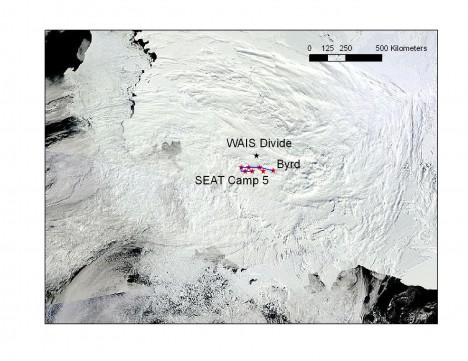
By Lora Koenig
Byrd Station (Antarctica), 22 December —
The traverse team got hit with their first storm last night. Everyone is safe and well. Here is the MODIS satellite image over Antarctica from Dec 21, 2011 showing the storm covering most of West Antarctica. The team experienced 35 to 40 knot winds with blowing snow.
It is hard to explain what it is like to be in an Antarctic storm but I will try. First, you should know that during Happy Camper training everyone goes through a drill to simulate a whiteout storm where they make you put a white bucket on your head. While this does simulate the fact that you cannot see in a storm it does not capture the complete experience. In an Antarctic storm , similar to the one the team experienced, the snow blows around so much that if were in a neighborhood you certainly could not see the house directly across the street. The blowing snow builds up in piles around the tents and has to be dug out occasionally to keep the tents from getting buried. When you step outside to shovel you have to make sure all of your skin is covered because the blowing snow stings when it hits your face, just like being sand blasted. During the storm the team will only leave their tents if they have to and flags are put up about every 10 feet, forming paths between the tents, so no one will get lost.
The snowmobiles and sleds are always parked downwind from the camp and strapped down just in case a storm rolls in. In a bad storm the snowmobile engines can get packed in with snow that has to be dug out once the storm ends and before the snowmobile can be started.
The team is holding at Camp 5 today and securing camp yet again. There is another storm on the way. The team will rest and bunker down in their tents for a few more days until the weather clears. They will probably open a few holiday presents early that contain card games to keep them occupied while they wait.
By Lora Koenig
McMurdo Station (Antarctica), 15 December — Today the Traverse Team traveled from SEAT Camp 2 to SEAT Camp 3. They picked up their fuel cache at Camp 3 and enjoyed the chocolate chip cookies that were inside. So far, the team has drilled three ice cores and traveled over 220 kilometers (136.7 mi). They will be at Camp 3 for at least two days to drill two ice cores in this area, which is the highest accumulation site on the traverse. The accumulation here will be close to 1 meter (3.28 feet) per year, while at Byrd is was over10 centimeters (3.9 inches) per year. The team is traveling fast and making up lost time each day.
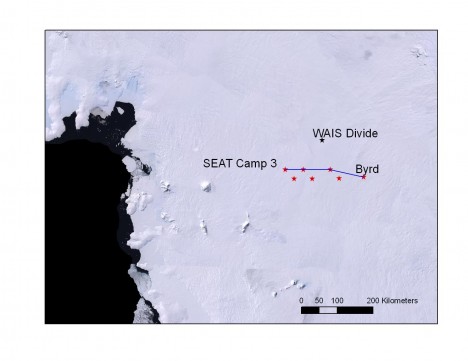
I am in McMurdo, waiting for a plane to fly back to Christchurch, New Zealand. The plane will arrive shortly after 4 AM. The C-17 planes have to land in the middle of the night because the days are already too warm, and the ice on the runway too soft, for a plane to land during daylight. So they are landing in the wee hours of the morning, which corresponds to the coldest part of the day and the hardest ice conditions. Once I get on a plane, I will be in transit for 60 hours, until I reach my home in Maryland.
I will leave Antarctica on the same plane than the Prime Minister of Norway, who was just at the South Pole to celebrate the 100th Anniversary of Ronald Amundsen being the first man to reach the South Pole. Our traverse team is still following in Amundsen’s footsteps, traveling over the ice to gain a better understanding of Antarctica.
By Lora Koenig
Byrd Station (Antarctica), 13 December — Well, I am still at Byrd Camp. One plane for the day from McMurdo has already been canceled and two more are scheduled. Byrd has not had a flight in over a week, and they are trying to get as many flights from McMurdo in as they can. There are still science teams waiting to get here. Also, the camp would like some freshies (fruits and vegetables), to increase moral. I shoveled some more today for the camp and did some house mouse choirs, which included doing the dishes, sweeping, and washing the tables. I may as well stay busy while I am waiting.
The team is traversing to Camp 2 today. They finished the ice core at Camp 1 and all the science is going well. When I last spoke with them, they were going out to locate their fuel cache, so they will have a nice loaf of bread to have with dinner tonight.
I just heard that my plane is in route, so I just may get to McMurdo tonight.
By Lora Koenig
Byrd Station (Antarctica), 12 December —The traverse team left yesterday and made it to Camp 1, 95 kilometers (59 miles) away. I spoke with Michelle last night; they had a few problems yesterday. One was that some bolts on the bottom of the radar sled came loose and the sled started to detach from one of the snowboards that serves as the sled runner. Ludo saw this early in the traverse (3 km, or 1.8 mi, out) and he and Clem fixed the sled with the spare parts kit. They used up all of the spare bolts to fix it. Last night, Michelle and Randy relayed the specifics of the bolts to me and I asked the Byrd mechanic, Paul, if he had any bolts to spare. He did. I added the bolts to the cache list.
The radar team had one additional problem. At some point, with all of the bumping of the sled, the GPS became unplugged. Without the GPS running we cannot tell where the radar data was taken. Ludo and Clem figured out that they had lost about 25 km (15.5 mi) of data. So they turned around, went back and recollected the data. They drove over 140 km (87 mi) yesterday! A huge day. Spirits were high and all was well at SEAT Camp 1 last night.
This morning I woke up at Byrd to patches of blue skies. The pilots told me that we would put in the caches if the weather was good enough for flying, so I jumped out of my sleeping bag ready to go. Also, if the weather held, I would catch a late night flight out of Byrd to McMurdo. I quickly packed my sleep kit and duffle so I would be ready to leave if a plane came. I went to the communications tent to talk with the pilots. At 7 AM they were already loading our 55-gallon drums of fuel in the DC-3 Bassler plane, so I knew we were going to try and put in the caches.
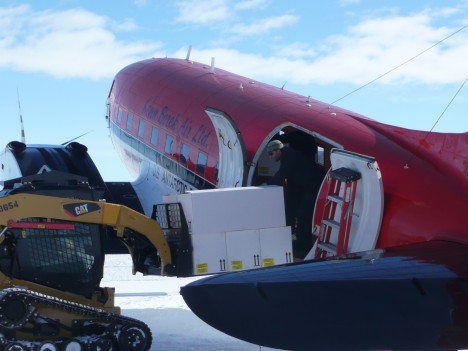
I made a quick stop in the galley on the way to the plane to see if they had any treats I could add to the caches. They gave me a loaf of bread and some home-baked chocolate chip cookies that I tucked into my backpack along with some Snickers bars, teas and letters for the team.
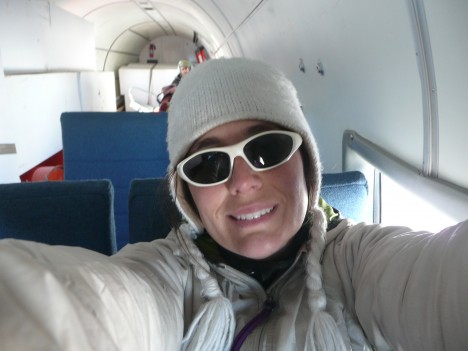
The Bassler took off just before 8 AM. At 8:15 we flew over the traverse team at SEAT Camp 1. I was up in the cockpit so I could see better. Everyone —Michelle, Jessica, Randy, Clem and Ludo— came out of the tents to wave at the plane and the copilot, who was flying the plane at the time, dipped a wing to wave hello. About 15 minutes later, the pilots started looking for a site to land and drop the first cache. The original GPS location did not have good surface definition so we landed about2 km (1.2 mi) away from the planned camp site. I left the bolts, bread, a note and an ice core box for the team.
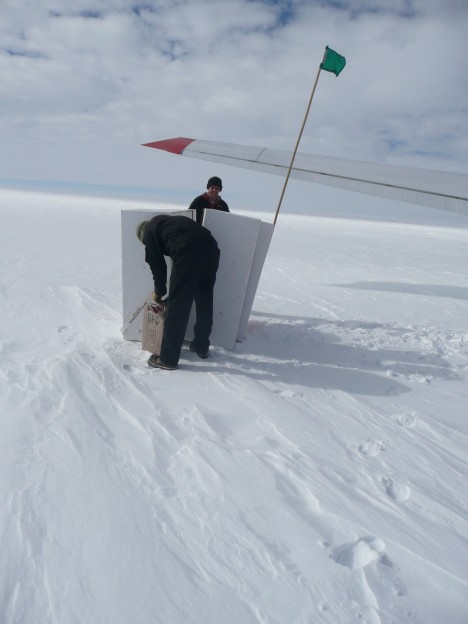
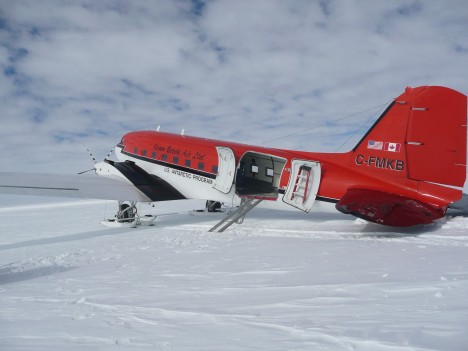
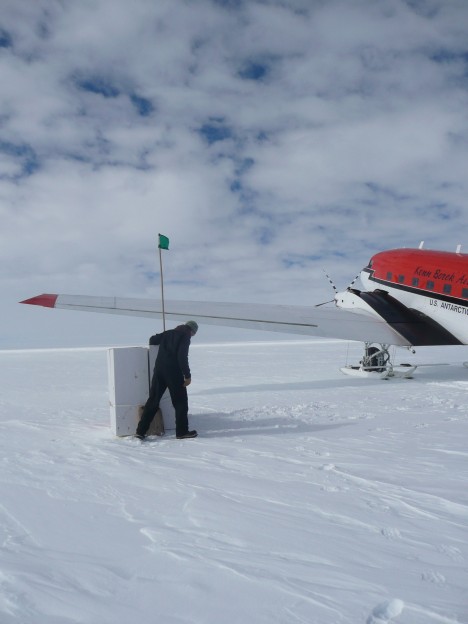
We continued to take off and land at each of the five cache sites. We were able to land exactly at the location of three of the five cache site and at two of the sites the team will have to snowmobile out to retrieve the caches. The caching went fast and took just over 2 hours. At each site, the team will get more premix and mogas, ice core boxes, and a surprise: At the first site, bread; at the second, cookies; at the third, crackers and stickers; at the forth Snickers bars and a Christmas card; and at the fifth, hot chocolate and tea. I told Michelle that I had left a letter at each site but they have no idea that they have gifts too. I hope they enjoy their surprises.
Along the route, I watched the surface carefully. I was looking for sastrugi (wind-blown snow dunes) that could slow the team’s progress, as well as for crevasses. We had already looked at the satellite imagery for crevasses, but it is always good to look with your own eyes. The surface conditions over the route were very smooth (though that could change with a big storm), and there were no crevasses.
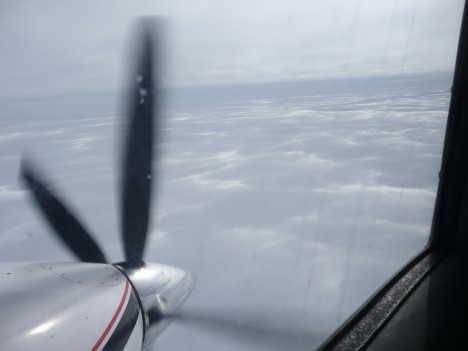
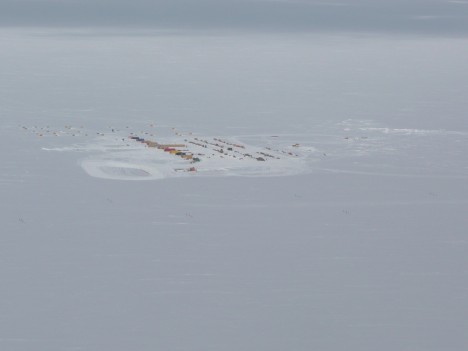
When we returned to Byrd, I needed to relay the cache positions to the team. I called Mac Ops (McMurdo Operations), where the team checks in everyday. Michelle knew to check-in in the evening to get the cache coordinates. I gave Mac Ops the cache locations and left a message for Michelle to call Byrd Camp for more information on the route conditions. Since I was expecting to get a flight out that afternoon I left detailed notes with the Byrd Camp manager, Kaija.
In the early afternoon, a fog bank came in over Byrd Camp and I knew I would not be leaving today. I spent the afternoon digging out fuel bladder to help contribute to camp choirs. There is always a lot of work to be done at field camps. At 9 PM I answered the call from Michelle to Byrd Camp. She was surprised to hear my voice. I told her about the route and she told me they had completed drilling the ice core at Camp 1. They plan on traveling to Camp 2 tomorrow. Great progress! The team is happy and excited to be making such good time. We are all happy that the caches are in so they can complete their work without worrying about getting good enough weather for a plane to fly.

I am now just waiting for a plane to arrive so I can get home. I am over a week delayed getting back. The good thing is that the traverse team has made up time at both Byrd and Camp 1 and are almost back on schedule after the delays in McMurdo.
Other news from Byrd Camp is that the camp population was very small last night. After the Bassler cached our supplies it took off to fly for Polenet, another science team at Byrd putting out seismometers and GPS stations. The Bassler could not return to Byrd due to fog that rolled in, and it had to divert to WAIS Divide camp, so about eight people are staying there for the night.
Here’s hoping for better weather tomorrow though the forecast does not look good.